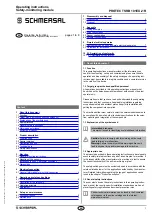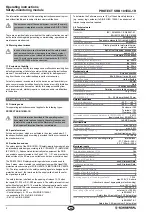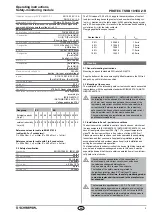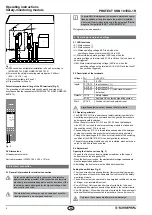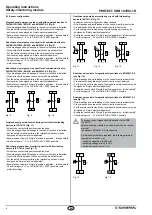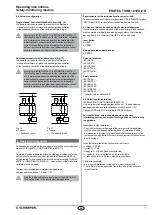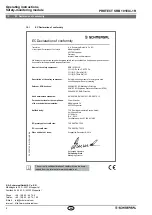
7
PROTECT SRB 101EXi-1R
Operating instructions
Safety-monitoring module
EN
8.4 Actuator configuration
Single-channel control with feedback circuit (Fig. 16)
• Suitable for increase in capacity or number of contacts by
means of contactors or relays with positive-guided contacts.
• If the feedback circuit is not required, establish a bridge.
According to IEC/EN 60079-11 (ABTN NBR IEC 60079-11),
the following must be observed for the installation: a distance
of ≥ 6 mm must be observed between the terminals of the
intrinsically safe current circuits and other intrinsically safe
current circuits. Between the terminals of the intrinsically
safe current circuits and other, non-intrinsically safe current
circuits, a distance of ≥ 50 mm must be observed.
Dual-channel control with feedback circuit (Fig. 17)
• Suitable for increase in capacity or number of contacts by
means of contactors or relays with positive-guided contacts.
• If the feedback circuit is not required, establish a bridge.
According to IEC/EN 60079-11 (ABTN NBR IEC 60079-11),
the following must be observed for the installation: a distance
of ≥ 6 mm must be observed between the terminals of the
intrinsically safe current circuits and other intrinsically safe
current circuits. Between the terminals of the intrinsically
safe current circuits and other, non-intrinsically safe current
circuits, a distance of ≥ 50 mm must be observed.
X1
X2
21
13
22
14
a)
K
A
S
L1
N
K
A
+24 VDC
X1
X2
21
13
22
14
a)
K
A
K
B
S
L1
N
K
B
K
A
+24 VDC
Fig. 16
a) Control
S
= Feedback circuit
Fig. 17
a) Control
S
= Feedback circuit
9. Simple electrical apparatus
An assessment of simple electrical apparatus must be executed accor-
ding to IEC/EN 60079-11 (ABTN NBR IEC 60079-11).
As simple electrical apparatus within the meaning of intrinsic safety do
not represent a potential source of ignition, the Directive 94/9/EC is
not applicable. To demonstrate the intrinsic safety according to IEC/EN
60079-14 (ABTN NBR IEC 60079-14) , a declaration of the manufactu-
rer therefore can be used.
The devices classified as simple electrical apparatus
can be used in the Zones 1 /2 and 21 / 22.
Only the intrinsically safe current circuit of the SRB 101EXi-
1R must be wired to the simple electrical apparatus.
Requirements for the intrinsically safe current circuit:
The enclosures have at least protection class IP 54 (EN 60529) for gas,
IP6X for dust (IP5X in case of non-conductive dusts in Zone 22).
9.1 Devices that can be used as simple electrical apparatus
On the basis of a valid declaration of the manufacturer with an assess-
ment as simple electrical apparatus, amongst others, the following
devices from K.A. Schmersal GmbH & Co. KG can be used:
reset button
EX-RDT...
EX-RDM...
Emergency stop control devices
EX-RDRZ...
Solenoid interlocks
(EX-)AZ 16-...
(EX-)AZ 415-...
(EX-)AZ 3350-...
(EX-)Z/T 235-...
(EX-)Z/T 335-…
Safety sensors
(EX-)BN 20-...
(EX-)BNS 33-...*
(EX-)BNS 120-...
(EX-)BNS 180-...
(EX-) BNS 250-...*
(EX-)BNS 303-...*
* however version without LED
9.2 Guidelines for installation
IEC/EN 60079-14 (ABTN NBR IEC 60079-14):
Use in explosive-endangered areas of Zones 1 / 2 and explosive-
endangered areas due to the presence of dust Zones 21 / 22.
(Category 2GD and 3GD according to ATEX directives)
For reset buttons, emergency stop command devices,
interlocking devices and magnetic safety switches, the following
is applicable:
Instructions for the installation:
• The risk of mechanical damage to the simple electrical apparatus
must be observed depending on the place of installation. Additio-
nal measures to provide for a mechanical protection are useful, for
instance when a potential difference through the earth wire can occur
due to damage.
Technical data in the intrinsically safe current circuit:
• Voltage U
o
: 33.6 V
• Current I
o
: 57 mA
• Capacity P
o
: 479 mW (linear characteristic)
• C
o
capacity: refer to the table with Ex-relevant data
• L
o
inductivity: refer to the table with Ex-relevant data
Cable/wire (example):
• A mechanical protection for the cable(s) must be provided.
• The cable(s) must be separated from other, non-intrinsically safe
current circuits.

